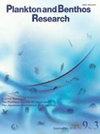Aquatic invertebrate’s Carbohydrate-binding module assists environmental cellulase to immobilize in wetland sediments
IF 0.6
4区 生物学
Q4 MARINE & FRESHWATER BIOLOGY
引用次数: 0
Abstract
: Carbohydrate-binding modules (CBMs) are non-catalytic protein domains that bind to carbohydrates, and have been well studied in microorganisms. Endogenous CBMs in aquatic invertebrates, however, have not yet been identified, and little is known about their ecological significance to wetland environments. Using an approach of characterizing a recombinant CBM ( Cj Cel9A) from a brackish bivalve, Corbicula japonica , this work identified Cj Cel9A-CBM ʼ s cellulose-binding activity. Scatchard plot analysis in the study of Cj Cel9A-CBM binding to α -cellulose showed a high corresponding partitioning coefficient (K r ) of 20.33, indicating Cj Cel9A-CBM ʼ s high affinity for cellulose. In addition, this affinity tolerated a high ion concentration buffer system, consistent with C. japonica ʼ s adaption to brackish wetland environments. Moreover, immuno-scanning electron microscopy (immuno-SEM) suggested that Cj Cel9A-CBM binds to α -cellulose unevenly, which was further determined to be caused by its higher affinity for crystalline cellulose (Cellulose I, mostly seen in plant leaves). Together, these findings suggest that Cj Cel9A-CBM is capable of immobilizing its associated catalytic domain on environmental crystalline cellulose (i.e., fallen leaves) in wetland sediments. Most importantly, they could provide a reasonable answer to a question recognized broadly in wetland ecologists, namely, why many wetland sediments have constant cellulase activities, although the sediments are being washed almost every day.水生无脊椎动物的碳水化合物结合模块帮助环境纤维素酶固定在湿地沉积物中
碳水化合物结合模块(CBMs)是与碳水化合物结合的非催化性蛋白质结构域,在微生物中已经得到了很好的研究。然而,水生无脊椎动物的内源性CBMs尚未被鉴定,其对湿地环境的生态意义也知之甚少。利用从苦盐双壳类植物Corbicula japonica中提取的重组CBM (Cj Cel9A)的方法,本研究鉴定了Cj Cel9A-CBM的纤维素结合活性。对Cj Cel9A-CBM与α -纤维素结合的Scatchard图分析表明,Cj Cel9A-CBM与α -纤维素结合的分配系数(K r)高达20.33,表明Cj Cel9A-CBM对纤维素具有较高的亲和力。此外,这种亲和性可以耐受高浓度离子缓冲系统,这与粳稻对微咸湿地环境的适应一致。此外,免疫扫描电镜(immune - sem)显示,Cj Cel9A-CBM与α -纤维素结合不均匀,进一步确定这是由于其对结晶纤维素(纤维素I,主要见于植物叶片)具有较高的亲和力。综上所述,这些发现表明Cj Cel9A-CBM能够将其相关的催化结构域固定在湿地沉积物中的环境结晶纤维素(即落叶)上。最重要的是,它们可以为湿地生态学家广泛认可的一个问题提供合理的答案,即为什么许多湿地沉积物具有恒定的纤维素酶活性,尽管沉积物几乎每天都被洗涤。
本文章由计算机程序翻译,如有差异,请以英文原文为准。
求助全文
约1分钟内获得全文
求助全文
来源期刊

Plankton & Benthos Research
Agricultural and Biological Sciences-Aquatic Science
CiteScore
1.30
自引率
0.00%
发文量
32
期刊介绍:
Plankton and Benthos Research is a peer-reviewed journal publishing quarterly original papers, reviews and notes dealing with any aspect of the biology and ecology of planktonic and benthic organisms and their interactions with the environment in any aquatic system, and is open to all scientists around the world. Submission of a paper is held to imply that it represents an original contribution not previously published and that it is not being considered elsewhere.
 求助内容:
求助内容: 应助结果提醒方式:
应助结果提醒方式:


